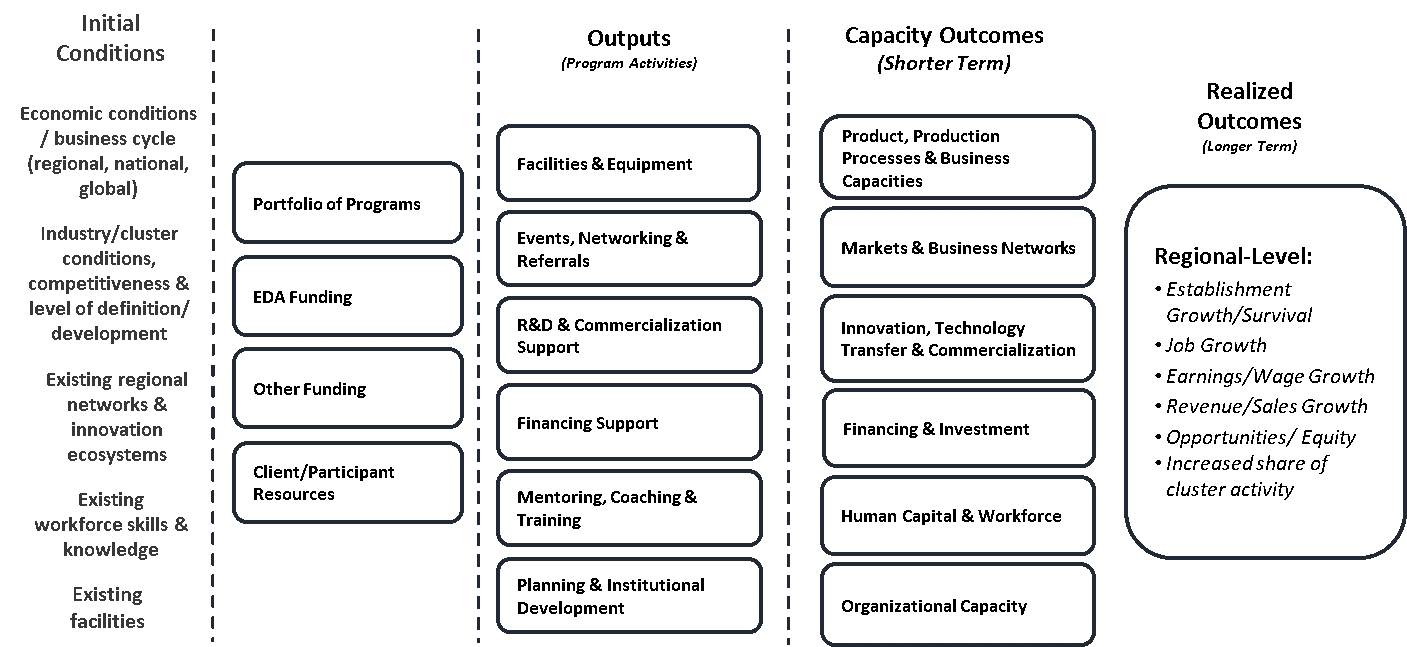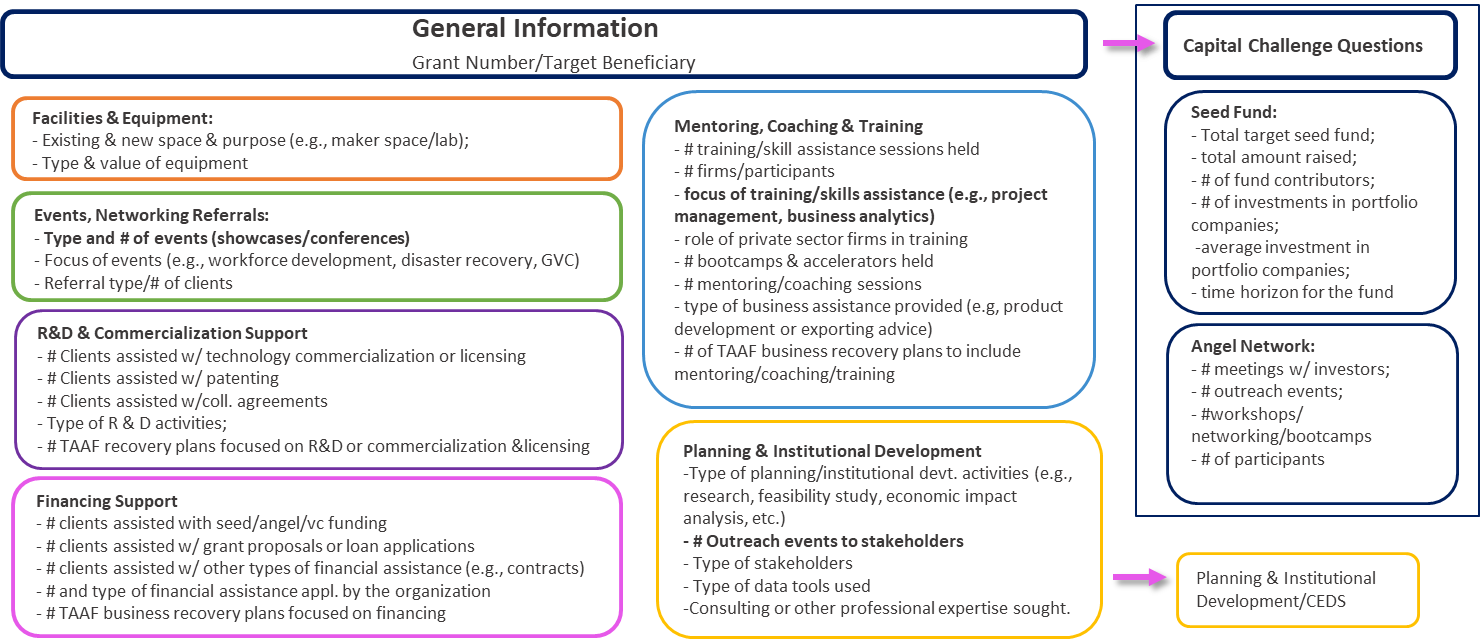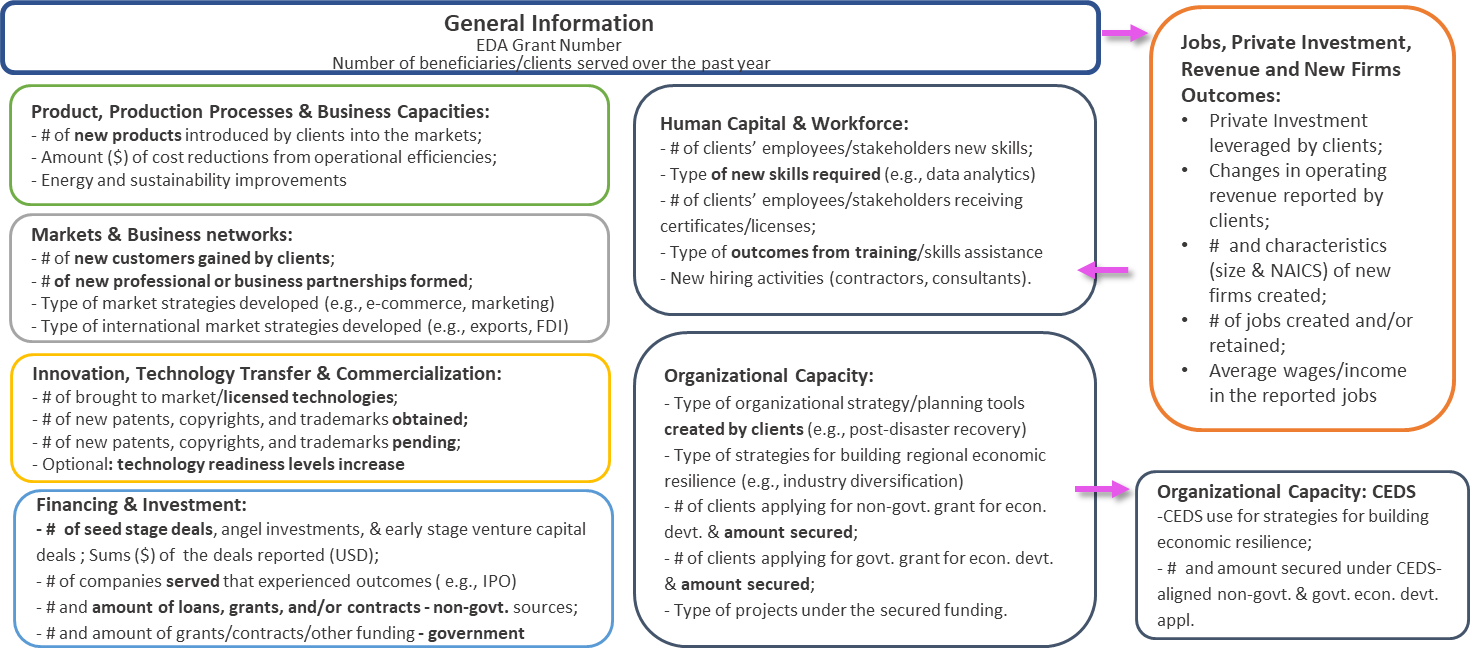New Performance Data Collection Instruments and Processes
* This applies ONLY to non-infrastructure programs. Infrastructure (construction) programs will continue to follow existing processes for GPRA data collection.
Recorded Webinars
- Educational Association of University Centers Webinar - December 2020 (December 9, 2020)
- TAAF Grantee Webinar (December 7, 2020)
- NADO Webinar: EDA’s New GPRA Metrics and Data Collection Processes (December 3, 2020)
- EDA New Non-Infrastructure Metrics and Data Collection Processes (August 10, 2020)
Demo Videos
Build to Scale Grantees
- ED-916 – Semi-Annual Program Outputs Questionnaire Demo (September 10, 2020)
- ED-917 – Annual Outcomes Questionnaire for Grantees Serving Clients Demo (September 10, 2020)
Economic Adjustment Assistance - Non Construction Grantees
- ED-916 – Semi-Annual Program Outputs Questionnaire Demo (October 28, 2020)
- ED-918 – Annual Outcomes Questionnaire for EDA Grantees Demo (October 28, 2020)
Partnership Planning Grantees
- ED-916 – Semi-Annual Program Outputs Questionnaire Demo (October 5, 2020)
- ED-918 – Annual Outcomes Questionnaire for EDA Grantees Demo (October 8, 2020)
Revolving Loan Fund Grantees
- ED-916 – Semi-Annual Program Outputs Questionnaire Demo (October 14, 2020)
- ED-917 – Annual Outcomes Questionnaire for Grantees Serving Clients Demo (October 14, 2020)
University Center Grantees
- ED-916 – Semi-Annual Program Outputs Questionnaire Demo (September 23, 2020)
- ED-917 – Annual Outcomes Questionnaire for Grantees Serving Clients Demo (October 5, 2020)
Key Points to Remember
- All non-infrastructure grants, including revolving loan fund grants, awarded on or after 06/01/2020 will be subject to the new non-infrastructure data collection system.
- NOT all categories of questions will apply to the outputs or outcomes you expect from your project, so you will be able to bypass any category that is not applicable to your project or skip or select "N/A" in the cases of inapplicable questions.
- The last section of the questionnaires contains an optional geographic information and narrative section where you can submit a success story or any other information you would like to share about the project.
- ALL outcomes you report on should be attributable to the scope of work under the EDA grant.
- You can save your responses and return to filling out the questionnaires later.
- You can download your responses to keep track of your data.
- The semi-annual questionnaires will be distributed only during the period of performance of your grant.
- The annual questionnaires will be distributed for five years beginning with the start of the grant.
- For any questions about the questionnaires or the new process, email [email protected].
Grant Programs Covered
- Local Technical Assistance (LTA) (PDF)
- Economic Adjustment Assistance: Non-Construction/Non-RLF (PDF)
- Revolving Loan Fund (RLF)
- University Centers (UCs)
- Build to Scale (B2S)/Regional Innovation Strategies (RIS)
- Planning (PDF)
- Trade Adjustment Assistance for Firms (TAAF) (PDF)
Background
EDA collects and reports on performance measures in compliance with the Government Performance and Results Act of 1993 that, as amended by the GPRA Modernization Act of 2010, establishes requirements for all agencies to collect, analyze and report on their performance.
Currently, EDA collects performance data using the ED-915, ED-916, ED-917, and ED-918 forms. The forms that have been revised and replaced by the new data collection instruments are ED-916, ED-917, and ED-918.
New Data Collection Process
This new process will be entirely web-based. Links to the questionnaires will be distributed electronically to grant recipients by the Performance and National Programs Division according to the following schedule, beginning in December 2020:
ED-916 Semi-Annual Program Outputs Questionnaire
- Non-Infrastructure grant recipients with award start dates on or after 6/1/2020 will begin receiving the Semi-Annual Program Outputs Questionnaire in early December and then every six (6) months thereafter during the period of performance.
- This questionnaire will be distributed according to the start of the period of performance and ONLY during the period of performance.
- *For RLF grantees, this questionnaire will be distributed according to the recipient’s fiscal year and ONLY during the disbursement phase.
ED-917 and ED-918 Annual Program Outcomes Questionnaire for Grantees with (ED-917) and without (ED-918) Clients
- Non-Infrastructure grant recipients with award start dates on or after 6/1/2020 will begin receiving the Annual Program Outcomes Questionnaire (either the ED-917 or the ED-918) in June 2021 and then annually for five (5) years.
- This questionnaire will be distributed according to the start of the period of performance, annually for five (5) years.
- *For RLF grantees, this questionnaire will be distributed according to the recipient’s fiscal year, annually for five (5) years.
EDA non-construction awards with periods of performance beginning prior to June 1, 2020 are not subject to EDA’s updated GPRA reporting requirements. For this reason, recipients of non-construction awards with periods of performance beginning prior to June 1, 2020 no longer need to submit GPRA reports for such awards. Note, however, that EDA construction awards and some legacy revolving loan fund (RLF) awards are not yet subject to EDA’s updated GPRA reporting requirements and must continue to submit GPRA data collection Form ED-915.
New Data Collection Instruments
The revised or “new” ED-916, ED-917, and ED-918 instruments are grounded in years of cooperative research between EDA and leading research institutions including SRI International and UNC-Chapel Hill.
One of the results of this research was the refinement of the economic development metrics to fit a wide range of non-infrastructure economic development projects, their associated outputs and the intermediate, or capacity outcomes that were confirmed as key to sustainable long-term economic outcomes based on the Logic Model.
- The economic development logic model as illustrated above is grounded in several years of cooperative research by SRI International, U.S. Economic Development Administration, and other institutions. The components of the logic model, as delineated in this research, draw from a vast body of work on economic development theory and practice. The logic model depicted captures the logical progression of a grant program, from inputs to activities to immediate outcomes and long-term outcomes. Within each component of the logic model, different categories of inputs, outputs, and outcomes might occur depending on the program’s focus. (https://eda.gov/files/performance/ED-Logic-Model.pdf)
EDA will be collecting Program Outputs and Capacity Outcomes data directly from grantees with the newly revised ED-916, ED-917, and ED-918 instruments which will be distributed electronically through Qualtrics.
New ED-916 “Semi-Annual Program Outputs Questionnaire” (PDF)
The new ED-916 instrument is organized into the same categories of outputs or program activities as the logic model.
We do not expect that every single category of outputs will apply to your project, so in responding to this instrument, you will be able to select only the pertinent categories and questions while bypassing the inapplicable ones.
In fact, the logic embedded in the instruments will make many of the questions invisible to you.
You will be expected to respond to the applicable questions on program outputs, cumulatively, on a semi-annual basis for the duration of the period of performance of your grant.
New ED-917 “Annual Program Outcomes Questionnaire for Grantees Serving Clients” (PDF)
If under your grant’s scope of work, your organization serves clients or beneficiaries directly, you will receive an annual questionnaire ED-917. Once again, the instrument is organized into categories of questions with flexibility to bypass any categories of questions not applicable to you.
The instrument is split into two main sections: the first section asks about more traditional, longer term outcomes, such as job creation and retention, private investment leveraged, and operating revenue changes. In each case, you will have an option to click “non-applicable” or select an option that states that such outcomes are expected but are not known at the time of your responding to the questionnaire.
The second section covers a broader set of capacity outcomes to allow our grantees to report on important milestones and intended outcomes that can be more specific to their grants. Unlike before, we will be capturing information on such key outcomes as new product introductions, expansion of business networks, and new financing and human capital improvements.
New ED-918 “Annual Program Outcomes Questionnaire for Grantees without Clients” (PDF)
The ED-918 instrument mirrors the ED-917 but is intended for the EDA grantees who do not serve clients directly but organize or develop strategies, studies, and plans that achieve outcomes to help grow regional economies.
Information You Should Have Available
In addition to reviewing the PDF versions of the ED-916 and either the ED-917 or the ED-918 as provided above, you should also make every effort to gather the following information prior to completing the questionnaires, regardless of which EDA grant program you have an award under:
- Industry specific NAICS codes: There are a number of questions for which having these codes ready will greatly speed up the time it takes to complete the questionnaires.
- Census tract numbers: It is becoming increasingly important for EDA to capture and report on location-specific information which requires us to know to the greatest precision possible the location of each of EDA’s awards. Having census tract location data available for your project (or county names if you are serving an entire county) will be very helpful for us as we gather and analyze the data from these questionnaires.








